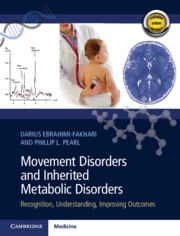Book contents
- Movement Disorders and Inherited Metabolic Disorders
- Movement Disorders and Inherited Metabolic Disorders
- Copyright page
- Dedication
- Contents
- Contributors
- Preface
- Acknowledgments
- Section I General Principles and a Phenomenology-Based Approach to Movement Disorders and Inherited Metabolic Disorders
- Chapter 1 Treatable Metabolic Movement Disorders: The Top 10
- Chapter 2 The Importance of Movement Disorders in Inborn Errors of Metabolism
- Chapter 3 The Importance of Inborn Errors of Metabolism for Movement Disorders
- Chapter 4 Imaging in Metabolic Movement Disorders
- Chapter 5 Biochemical Testing for Metabolic Movement Disorders
- Chapter 6 Genetic Testing for Metabolic Movement Disorders
- Chapter 7 A Phenomenology-Based Approach to Inborn Errors of Metabolism with Ataxia
- Chapter 8 A Phenomenology-Based Approach to Inborn Errors of Metabolism with Dystonia
- Chapter 9 A Phenomenology-Based Approach to Inborn Errors of Metabolism with Parkinsonism
- Chapter 10 A Phenomenology-Based Approach to Inborn Errors of Metabolism with Spasticity
- Chapter 11 A Phenomenology-Based Approach to Inborn Errors of Metabolism with Myoclonus
- Section II A Metabolism-Based Approach to Movement Disorders and Inherited Metabolic Disorders
- Section III Conclusions and Future Directions
- Appendix: Video Captions
- Index
- References
Chapter 3 - The Importance of Inborn Errors of Metabolism for Movement Disorders
from Section I - General Principles and a Phenomenology-Based Approach to Movement Disorders and Inherited Metabolic Disorders
Published online by Cambridge University Press: 24 September 2020
- Movement Disorders and Inherited Metabolic Disorders
- Movement Disorders and Inherited Metabolic Disorders
- Copyright page
- Dedication
- Contents
- Contributors
- Preface
- Acknowledgments
- Section I General Principles and a Phenomenology-Based Approach to Movement Disorders and Inherited Metabolic Disorders
- Chapter 1 Treatable Metabolic Movement Disorders: The Top 10
- Chapter 2 The Importance of Movement Disorders in Inborn Errors of Metabolism
- Chapter 3 The Importance of Inborn Errors of Metabolism for Movement Disorders
- Chapter 4 Imaging in Metabolic Movement Disorders
- Chapter 5 Biochemical Testing for Metabolic Movement Disorders
- Chapter 6 Genetic Testing for Metabolic Movement Disorders
- Chapter 7 A Phenomenology-Based Approach to Inborn Errors of Metabolism with Ataxia
- Chapter 8 A Phenomenology-Based Approach to Inborn Errors of Metabolism with Dystonia
- Chapter 9 A Phenomenology-Based Approach to Inborn Errors of Metabolism with Parkinsonism
- Chapter 10 A Phenomenology-Based Approach to Inborn Errors of Metabolism with Spasticity
- Chapter 11 A Phenomenology-Based Approach to Inborn Errors of Metabolism with Myoclonus
- Section II A Metabolism-Based Approach to Movement Disorders and Inherited Metabolic Disorders
- Section III Conclusions and Future Directions
- Appendix: Video Captions
- Index
- References
Summary
Movement disorders can present a diagnostic challenge, particularly those with onset at an early age as one component of a complex neurodevelopmental disorder. With advances in next-generation sequencing technologies, the number of genes associated with movement disorders has been rapidly increasing over the last few years. Some of these genes encode transport proteins or enzymes within well-characterized metabolic pathways and their abnormal function results in disorders defined as inborn errors of metabolism (IEMs). Although individually rare, IEMs have a collective estimated incidence of 1:800 to 1:2,500 live births [1]. Movement disorders are a common symptom in IEMs affecting the central nervous system [2]. In general, movement disorders are not the sole symptom of these disorders, but are more often part of complex phenotypes that include other neurological and systemic signs and symptoms. The ability to recognize IEMs is crucial for clinicians evaluating patients presenting with movement disorders, as some IEMs are amenable to therapy, including specific dietary therapies or supplementation with vitamins, minerals, or cofactors that can prevent intoxication or treat deficiencies [3].
- Type
- Chapter
- Information
- Movement Disorders and Inherited Metabolic DisordersRecognition, Understanding, Improving Outcomes, pp. 26 - 42Publisher: Cambridge University PressPrint publication year: 2020



